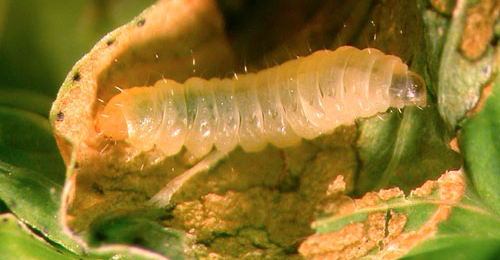|
||||||
|
Euspilapteryx
auroguttella Stephens, 1835 Gold-dot Slender Euspilapteryx
auroguttella Stephens, 1835. Ill.
Brit. Ent. Haust. 4: 363 |
|||||||||||||||||||||||||||||||||||||||||||||||||||||||||||||||||||||||||||||||||||||||||||||||||||||||||||||||
|
Leaf-miner: Larva initially feeding in a gallery which turns to a blotch and finally one or more conical folds are made (UKMoths). The mine begins as an, occasionally quite long, lower-surface epidermal corridor. Its last section is widened into a blotch. Only then the larva begins to consume parenchymatous tissue and to line the inside of the mine with silk. The upper surface of the mine turns orange brown, and the leaf folds itself around the mine. Frass in a clump in a corner of the mine. In the end the larva leaves its mine, and then lives free in a leaf tip that has been folded downwards (Bladmineerders van Europa). Larva: The larvae of moths have a head capsule and chewing mouthparts with opposable mandibles (see video of a gracillarid larva feeding), six thoracic legs and abdominal legs (see examples). The larva is illustrated in Bladmineerders van Europa.
Pupa: The pupae of moths have visible head appendages, wings and legs which lie in sheaths (see examples). Adult: The adult is illustrated in UKMoths. The species is included in mothdissection.co.uk. Hosts in Great Britain and Ireland:
Hosts elsewhere:
Time of year - larvae: June; September-October (British leafminers). Time of year - adults: There are two generations, moths being on the wing in May and August. The flight time is evening onwards, and sometimes it can be attracted to light (UKMoths). Distribution in Great Britain and Ireland: A fairly common and well-distributed species throughout much of the British Isles (UKMoths) including Anglesey, Bedfordshire, Berkshire, Breconshire, Buckinghamshire, Caernarvonshire, Cambridgeshire, Denbighshire, Derbyshire, Dorset, Dunbartonshire, Durham, East Cornwall, East Gloucestershire, East Kent, East Norfolk, East Suffolk, East Sussex, Flintshire, Glamorgan, Herefordshire, Hertfordshire, Isle of Wight, Kincardineshire, Leicestershire, Merionethshire, North Aberdeenshire, North Hampshire, North Lincolnshire, North Somerset, North Wiltshire, Nottinghamshire, Pembrokeshire, Shropshire, South Aberdeenshire, South Wiltshire, Stafford, West Cornwall, West Gloucestershire, West Lancashire, West Norfolk, West Perthshire, West Suffolk, Westmorland and Worcestershire (NBN Atlas). See also British leafminers distribution map, as Eucalybites auroguttella. Also recorded in the Republic of Ireland and Northern Ireland (Fauna Europaea and National Biodiversity Data Centre Map). as Eucalybites auroguttella. Distribution elsewhere: Widespread in continental Europe including Albania, Austria, Balearic Is., Belgium, Bosnia and Herzegovina, Corsica, Croatia, Czech Republic, Danish mainland, Estonia, Finland, French mainland, Germany, Greek mainland, Hungary, Italian mainland, Latvia, Lithuania, Luxembourg, Macedonia, Norwegian mainland, Poland, Portuguese mainland, Romania, Russia - Central and Northwest, Sardinia, Sicily, Slovakia, Spanish mainland, Sweden, Switzerland, The Netherlands, Ukraine and Yugoslavia. Also recorded in the Near East (Fauna Europaea). NBN Atlas links to known host species:
British and Irish Parasitoids in Britain and elsewhere: Currently unknown. |
|||||||||||||||||||||||||||||||||||||||||||||||||||||||||||||||||||||||||||||||||||||||||||||||||||||||||||||||
|
|
|
| External links: | Search the internet: |
Belgian Lepidoptera |
Find
using Google Find using Google Scholar Find images using Google |
| Last updated 25-May-2019 Brian Pitkin | ||

